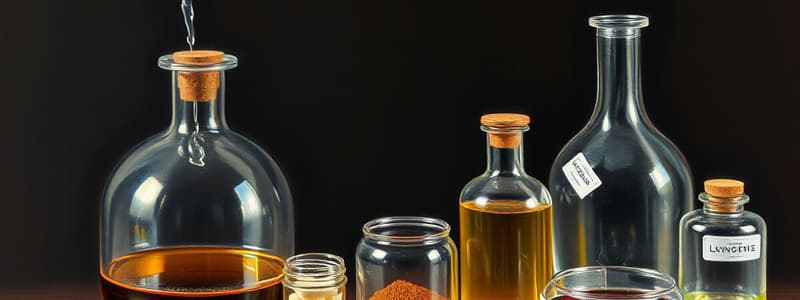Podcast
Questions and Answers
What defines a pure substance?
What defines a pure substance?
- It uniformly mixes with other substances.
- It contains multiple types of atoms in varying proportions.
- It has a fixed composition that cannot be separated by physical means. (correct)
- It can be separated into its components physically.
Which of the following is an example of a compound?
Which of the following is an example of a compound?
- Pasta
- Water (correct)
- Gold
- Oxygen
Which statement accurately describes heterogeneous mixtures?
Which statement accurately describes heterogeneous mixtures?
- They always contain two substances.
- They have a uniform composition.
- They are visually indistinguishable.
- Their components can be separated by physical means. (correct)
What type of mixture allows for its components to be easily identified and separated?
What type of mixture allows for its components to be easily identified and separated?
Which of these is a characteristic of homogeneous mixtures?
Which of these is a characteristic of homogeneous mixtures?
How can compounds be formed?
How can compounds be formed?
Which of the following is NOT a characteristic of a pure substance?
Which of the following is NOT a characteristic of a pure substance?
What is an example of a homogeneous mixture?
What is an example of a homogeneous mixture?
Flashcards are hidden until you start studying
Study Notes
Composition of Matter
- Matter is defined as anything that has mass and occupies space, excluding energy.
- Matter is categorized into two main types: pure substances and mixtures.
Pure Substances
- A pure substance has a fixed composition that cannot be separated by physical means.
- Pure substances can be classified as elements or compounds.
- Elements consist of only one type of atom, such as gold, helium, or aluminum.
- Compounds are formed when two or more elements combine in fixed proportions (e.g., water is a compound of hydrogen and oxygen).
Examples of Compounds
- Water (H2O): consists of two hydrogen atoms and one oxygen atom.
- Sugar (C6H12O6): consists of six carbon atoms, twelve hydrogen atoms, and six oxygen atoms.
Mixtures
- Mixtures contain two or more substances that can be separated by physical means and do not have fixed compositions.
- Components of a mixture can vary in proportion (e.g., fruit salad can have varying amounts of grapes and pineapples).
Heterogeneous vs. Homogeneous Mixtures
- Heterogeneous mixtures: different materials can be visually distinguished (e.g., pizza, trail mix, granite).
- Homogeneous mixtures: components are uniformly blended and cannot be easily seen (e.g., soda, vinegar, saltwater).
- In soda, water, sugar, flavoring, coloring, and carbon dioxide gas are mixed evenly.
- Vinegar appears clear but contains acetic acid and water mixed uniformly.
Key Characteristics
- Heterogeneous mixtures display distinct substances that can be separated visually.
- Homogeneous mixtures have a uniform composition throughout, making it difficult to identify individual components.
Composition of Matter
- Defined as anything that possesses mass and occupies space, excluding energy.
- Divided into two primary categories: pure substances and mixtures.
Pure Substances
- Characterized by a fixed composition that cannot be altered through physical methods.
- Classified into two types: elements and compounds.
- Elements: Composed of a single type of atom (e.g., gold, helium, aluminum).
- Compounds: Formed by the chemical combination of two or more elements in defined ratios (e.g., water is a compound of hydrogen and oxygen).
Examples of Compounds
- Water (H2O): Contains two hydrogen atoms and one oxygen atom.
- Sugar (C6H12O6): Comprises six carbon atoms, twelve hydrogen atoms, and six oxygen atoms.
Mixtures
- Consist of two or more substances that can be separated by physical methods and lack fixed compositions.
- The proportions of components in a mixture can vary (e.g., fruit salad may have different amounts of grapes and pineapples).
Heterogeneous vs. Homogeneous Mixtures
- Heterogeneous Mixtures: Consist of visibly distinct materials that can be easily identified (e.g., pizza, trail mix, granite).
- Homogeneous Mixtures: Features components that are uniformly distributed and not easily visible (e.g., soda, vinegar, saltwater).
- In soda, various elements such as water, sugar, flavoring, coloring, and carbon dioxide are mixed uniformly.
- Vinegar, although clear, contains acetic acid and water that are combined evenly.
Key Characteristics
- Heterogeneous Mixtures: Exhibits distinct components that can be separated visually.
- Homogeneous Mixtures: Presents a consistent composition throughout, making individual components difficult to distinguish.
Studying That Suits You
Use AI to generate personalized quizzes and flashcards to suit your learning preferences.




